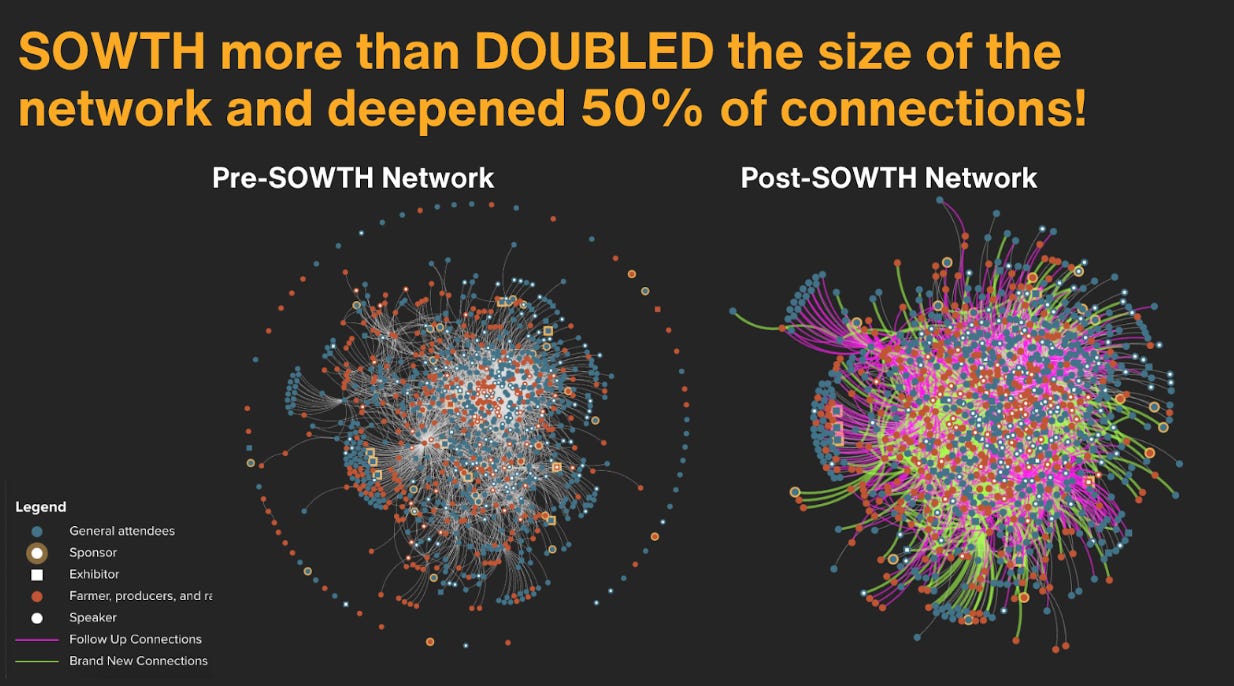Four For Friday | Aug 15, 2025
LF185 | Visualizing a conference, AI hope vs hype, the exposome and the economic power of healthy brains + AI tool: Fyxer
Welcome to this week’s Four For Friday - sent from the idyllic Suffolk coast - with four stories covering impact metrics, AI and, longevity and economic growth, plus an all-round AI tool to check out.
1. Measuring the Real Impact of a Conference
What if you could see the tangible impact of your event?
I’ve struggled with that while running annual conferences in the past - there was a lot of goodwill and anecdotal evidence we were helping, but limited ways to prove it. One proxy was whether people returned the next year and sponsors opened their wallets, but that’s rather indirect.
Project Pollinate addressed this in a novel way - asking attendees about the strength and size of their networks before and after their event about farming in the US. They were able to show the 3-day conference ‘deepened the network by reigniting 50% of existing connections and expanded the network to twice its size overall and 2.5 times for farmers’.
Here’s the beautiful Kumu graph they built out - would love to hear of others’ experience doing something similar.
The So What? A useful step for illustrating the impact of an event - if it can be done in an easy way with high takeup - and one that could be supplemented with additional impact data such as deals done and money spent.
2. AI Hope vs Hype
Trying to follow AI announcements is as exhausting as it is bewildering. One breathless AI article after the next makes it sound like the Second Coming, or bigger, the next Taylor Swift Tour. While others are calling it all a big, unsustainable scam.
A bullish note comes from The Economist, which explores the potential impact that AI may have on economic growth. The article suggests:
Artificial General Intelligence could lift annual GDP growth to 20-30%
Think Tank Epoch has a growth model that suggests GDP growth could pass 20% once AI automates one-third of tasks.
According to this school of thought, he optimal AI investment to seize the opportunity is $25 trillion annually, which dwarves OpenAI's $500 billion Stargate project
Oh, but with all that could come interest rates of 20-30%. Unprecedented times.
On the ‘it’s all hype’ side is AI Con, a book that aims to deflate the sector and call out the AI leaders as rogues and charlatans. It make some valid points but seems polemical about denying any real value from this remarkable set of services we’re seeing.
More relevant for LF readers perhaps is this fact-filled story, the Hater’s Guide to AI.
The ‘Magnificent 7’ tech companies have spent $560 billion on AI, generating only $35 billion revenue from 2024-3025.
42% of NVIDIA revenue from 5 companies; NVIDIA represents 7.5% of S&P 500
OpenAI loses billions despite $10B revenue; Anthropic loses $3B on $4B revenue
Only 12 generative AI companies make over $100 million annually worldwide
And another article dosing the fantastic claims with cold water is Cal Newport’s in The Atlantic.
The So What? Most commentators are conflating the tech with the attached business models and social constructs that make it either transformational or a nothing-burger. We need to get civil society and politicians involved in these decisions that impact society, not just the tech bros.
3. From Cell to Cities: Tina Woods on the exposome
Longevity expert - and raver - Tina Woods has a new Substack, and this piece does a nice summary on the ‘exposome’ : ‘the total sum of everything we’re exposed to—our air, diet, stress, social connections—and how it impacts our biology over a lifetime.’ The piece critiques the lack of population and place-based thinking when it comes to longevity research and shares some powerful stats about the impact of your environment on your long-term health:
Increasing tree cover in European cities to 30% cuts heat deaths by a third.
London’s ULEZ expansion cut roadside NO₂ by 14%, PM₂.₅ by 31%.
20 mph limits reduced London road collisions by 35% and casualties by 36%.
Green-mobility projects yield up to €143 return per €1 invested.
10% traffic reduction lowers peak noise 28% and PM exposure 22%
The So What? Places impact long-term health in multiple ways; today’s individual-focused longevity researchers don’t generally take them into account.
4. The economic boost of strong brains
An FT piece showing that brain training isn’t just for the elderly. It seems it can also boost the success of school kids, and have long-term compounded economic impacts. And on the flip side, brain damage, for example, due to pollution’s particulate matter, has significant economic and social impacts. In Israel, they found that students taking exams on days of high air pollution fared worse.
The paradox of our tech tools is that search engines and social media erode memory, reading capacity and concentration abilities, yet tech and AI fluency are increasingly required in the workplace. The article refers to a startup - Nuroe - that is targeting boosting working memory and focus in kids.
The So What? More evidence of the impact of prevention and in particular the exposome on long-term economic and social outcomes.
Bonus AI Tip of the Week: Fyxer
Have been trying out Fyxer and am impressed. It’s showing how meeting notes are becoming commoditized and new features are being bundled in - it includes automatic drafts of responses to your emails, and a calendering function in addition to robust meeting notes and analysis. Up there with Granola in terms of usability (but unlike Granola, it does announce itself on meetings).
That’s all for now - happy weekend everyone.
- Stephen



